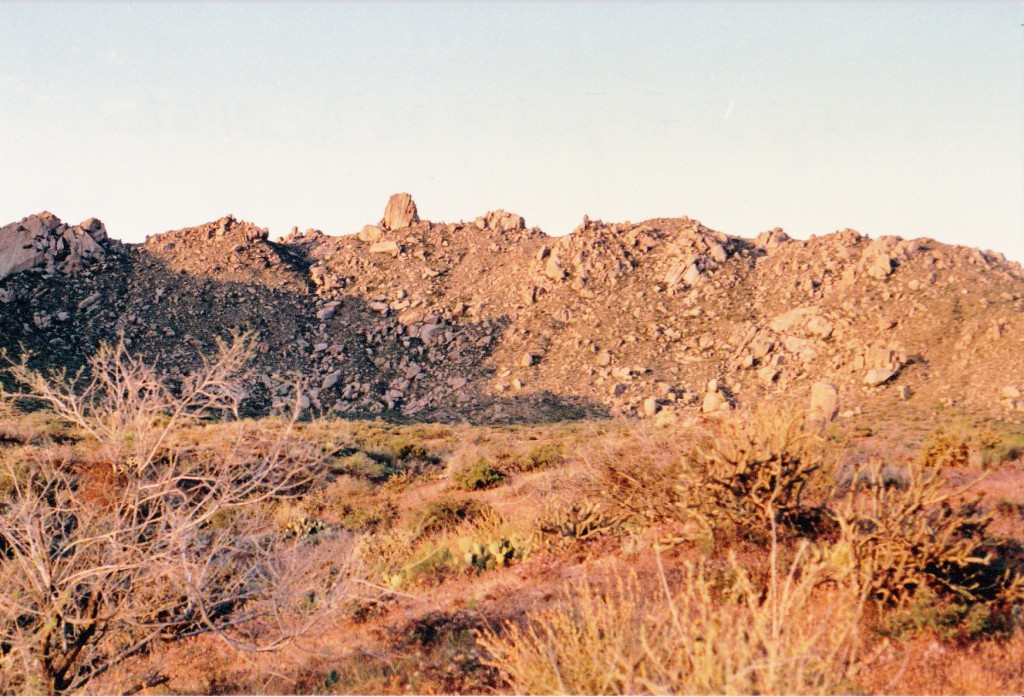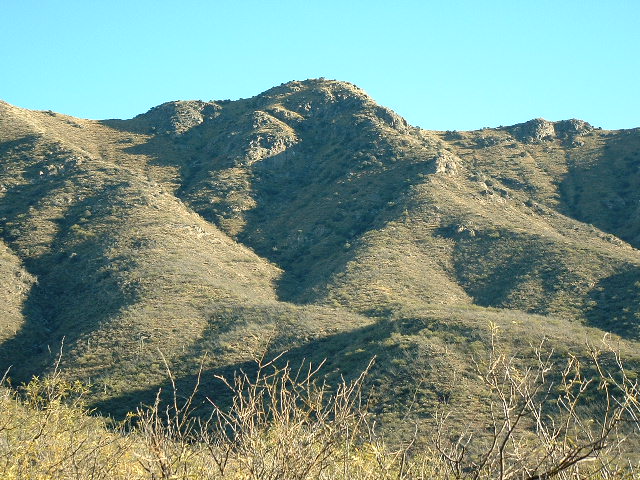Here in Arizona lives an animal commonly known as a javelina, or collared peccary. These creatures occupy the southern third, more or less, of the state, and if you live where they live, you’ve almost certainly seen one and maybe interacted with one in some way. As the link explains, they are social animals, usually found in groups. I’ve seen them many times over the years in my desert travels, and I can’t recall a time when I saw a solitary individual – there was always more than one.
The first time I saw javelina in the desert was in 1987. It was a hot day and I was by myself when I flushed one. As it ran away, I was startled and it took me a moment to realize what it was that I was seeing. I wasn’t frightened, just startled. That’s how I usually saw them, during the daytime hours, and I always got the impression I had disturbed their sleep. It’s true that they avoid the worst of the heat by resting under the cover of vegetation, so when I came tramping through, if I were too close they would leave their resting place and quickly run away. Even though their legs are short compared to those of a human, they can easily outrun you in the terrain they know so well.
Javelina get a bad rap, even by people who live in the desert and should know better. Tall tales abound of mayhem and even murder inflicted by javelina upon humans, but that’s all they are – tall tales. Yes, javelina have attacked and even bitten humans, but very rarely and only when they feel threatened and are trying to protect themselves or their young. If someone’s dog attacks javelina, they will fight back hard, and with their long, sharp canine teeth can inflict serious injury. No human has ever been killed by javelina, at least not by collared peccaries like we have here in Arizona.
I can recall only one time in thirty years of meeting javelina where I was afraid. It was a hot April morning in 1987 – I was coming down from the summit of East End, the high point of the McDowell Mountains. In a jumbled boulder-field low down on the north side of the peak, I heard, then saw, an adult javelina maybe 50 feet away. In short order, more came into view as they started moving in the brush – lots of adults and plenty of little ones too. There must have been 20 of them. Several of the big ones were snorting and had the hair on their back raised up, which they do when they feel threatened. I must have wandered into the midst of their resting area and caught them off guard. Several of the big adults moved closer to me, so I climbed up on top of a 5-foot boulder where I knew they couldn’t reach me. The only thing I could think of was to look big and scary, so I started shouting and jumping up and down and waving my arms. It worked, and in probably less than a minute, they had all run off in one direction, babies and all, and, I’m sure, found each other again and re-grouped. That day still stands out in my mind, because it was the only time they’ve ever taken a defensive posture against me, and it was short-lived. Here is an old photo taken quite close to the encounter.
A lot of days are spent by me each year in the mountains, and I run into javelina a few times every year and always enjoy it, but there’s one very special experience I had that I want to share with you. Let me take you back to December 30, 2004. I left Tucson early in the day and drove out to the Tohono O’odham Indian Reservation. From the town of Sells, I headed south through the village of Topawa, and soon reached the Baboquivari District headquarters. There, I headed east on the dirt road which more or less parallels Fresnal Wash. Near Fresnal Hill and the settlement of Kahachi Miliuk, I turned northeast. Past Pitoikam, I followed the wash to the village of Chiuli Shaik. Just east of the village, I entered Fresnal Canyon where things narrowed considerably, and 1 1/2 miles from the village the road split. I chose the south fork and went up a really bad hill in 4WD, so rough that I prayed there’d be another way down when I returned. Almost two miles farther east was a major fork in the road, where I found a corral and windmill. Also, I spotted a vehicle and realized there were people nearby. I stopped and spoke with them. They were three generations of an O’odham family living in the area, out to harvest wild chiltepín peppers. They offered me a taste, but I chickened out – these can be extremely hot.
From the windmill, I took the north fork and drove across a few washes and went to a junction at 3,706′ elevation, then up a rough right fork where I parked several hundred yards later.
The day was pleasantly warm as I started out on foot. I picked a gentle ridge and followed it up to 3,850′ where I crossed a gully and carried on up another steep but easy ridge. I encountered eight cows grazing at 4,200′, passed them by and carried on another 1,100 vertical feet. That put me on the main spine of the Baboquivari Mountains. All I had to do was make a hard right turn and climb less than 200 vertical feet and there I was, on top of Peak 5481. There was a register, and it had been left by Mark Nichols only 12 days earlier. Wow, I had just missed him. It was no surprise to see his name there – Mark is one of Arizona’s most prolific peakbaggers, with a lifetime total way over 3,000 summits. There were no entries besides his.
Even though it was a perfect blue-sky desert day and the temperature wasn’t too chilly for December, I didn’t stick around too long. Down one ridge and then the other, I had dropped all the way back to 4,500′ when it happened. Remember that I was in the midst of telling you about a javelina experience? Well, here it is.
I was on easy ground and walking downhill, minding my own business, when I saw a full-grown javelina. It was maybe 30 feet away when I first noticed it, and it was walking calmly in the same direction. I stopped for a moment and it did too. When I started moving again, so did it – this was curious behavior. I walked slowly, just to see what it would do. Then I noticed that there was another one, also an adult, and it too was walking in the same direction, downhill. Within a few moments, I realized that there were three, then four, five, six – all adults. They seemed to have come out of nowhere – probably they’d been resting under bushes and were all awakened by my passing. Their eyesight is poor, but their senses of smell and hearing are sharp. I was walking slowly, and was now literally surrounded by the six of them. They were as close as five feet to me, and didn’t seem a bit concerned that I was there. By now, I wasn’t afraid of them either, not worried at all. Our little group kept walking together, down the ridge. I kept looking around to see if any of them seemed aggressive or on the verge of coming at me, but nope, they were as calm as could be. This amazing event lasted a full five minutes. Then, as suddenly as it started, it was over – my friends walked over to the side of the ridge and downhill in a different direction and were gone.
This was an amazing experience, one I’ve never had again. For five wonderful minutes, man and beast were one with the mountain. There was nothing negative or frightening about it, and I would love to live it all over again. I marveled at my good fortune – in thirty years of climbing in the desert, it’s only happened once. To this day, nobody can bad-mouth javelina around me, ’cause I’m not buying it. That’s my story, and I’m sticking to it.


